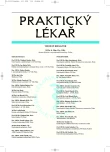Common basic classifications of child fractures
Authors:
T. Pešl; P. Havránek
Authors‘ workplace:
Přednosta: prof. MUDr. Petr Havránek, CSc.
; 3. lékařská fakulta a FTNsP Praha
; Klinika dětské chirurgie a traumatologie
; Univerzita Karlova v Praze
Published in:
Prakt. Lék. 2008; 88(10): 572-576
Category:
Various Specialization
Overview
Pediatric skeletal injuries of extremities can be classified into three main types:
1. diaphyseal fracture,
2. metaphyseal fracture, and
3. physeal injury.
The classification system should describe the location and morphology of the fracture and provide therapeutic information. It should be simple, understandable, logical and clinically relevant for children. On the other hand, we should not overlook the fact that a major purpose of classification systems is in facilitating documentation and data comparison between clinical studies. We present several common classification schemes which are widely used for the description of pediatric skeletal trauma. The classification schemes for specific anatomic locations are not the topic of this report.
Key words:
fracture, physis, physeal injury, classification, child.
Sources
1. Canale, S. T. Physeal injuries. In: Green, N. E., Swiontkowski, M. F. (eds.) Skeletal trauma in children. Philadelphia: Saunders, 2003.
2. Havránek, P. Dětské zlomeniny. Praha: Corvus, 1992.
3. Havránek, P., Pešl, T., Vlček, P. Obtížně diagnostikovatelné zlomeniny rostoucího dětského skeletu. Prakt. lék. 2008, 88, 7, s. 398-407.
4. Jones, E.T. Skeletal growth and development as related to trauma. In: Green, N. E., Swiontkowski, M. F. (eds.) Skeletal trauma in children. Philadelphia: Saunders, 2003.
5. Ogden, J.A. Injury to the growth mechanisms of the immature skeleton. Skeletal Radiol. 1981, 6, p. 237-253.
6. Peterson, H. A. Physeal fractures. Part 3. Classification. J. Pediatr. Orthop. 1994, 14, p. 439-448.
7. Salter, R.B., Harris, W.R. Injuries involving the epiphyseal plate. J. Bone. Joint. Surg. Am. 1963, 45, p. 587-622.
8. Slongo, T., Audigé, L., Schlickevei, W., Clavert,J-M., Hunter, J. Development and validation of the AO pediatric comprehensive classification of long bone fractures. J. Pediatr. Orthop. 2006, 26, 1, p. 43-49.
9. Slongo, T., Audigé, L., Clavert, J-M., Lutz, N., Frick, S., Hunter, J. The AO comprehensive classification of pediatric long-bone fractures. A web-based multicenter agreement study. J. Pediatr. Orthop. 2007, 27, 2, p. 171-180.
Labels
General practitioner for children and adolescents General practitioner for adultsArticle was published in
General Practitioner

2008 Issue 10
- Metamizole vs. Tramadol in Postoperative Analgesia
- Memantine in Dementia Therapy – Current Findings and Possible Future Applications
- Metamizole at a Glance and in Practice – Effective Non-Opioid Analgesic for All Ages
- What Effect Can Be Expected from Limosilactobacillus reuteri in Mucositis and Peri-Implantitis?
- Hope Awakens with Early Diagnosis of Parkinson's Disease Based on Skin Odor
Most read in this issue
- Guillain-Barré syndrome. Specific features of intensive care, potential for therapeutic use of plasmapheresis, and our experience
- Common basic classifications of child fractures
- Mentalization
- Uncommon nasopharyngeal tumor in old age - nasopharyngeal angiofibroma?
